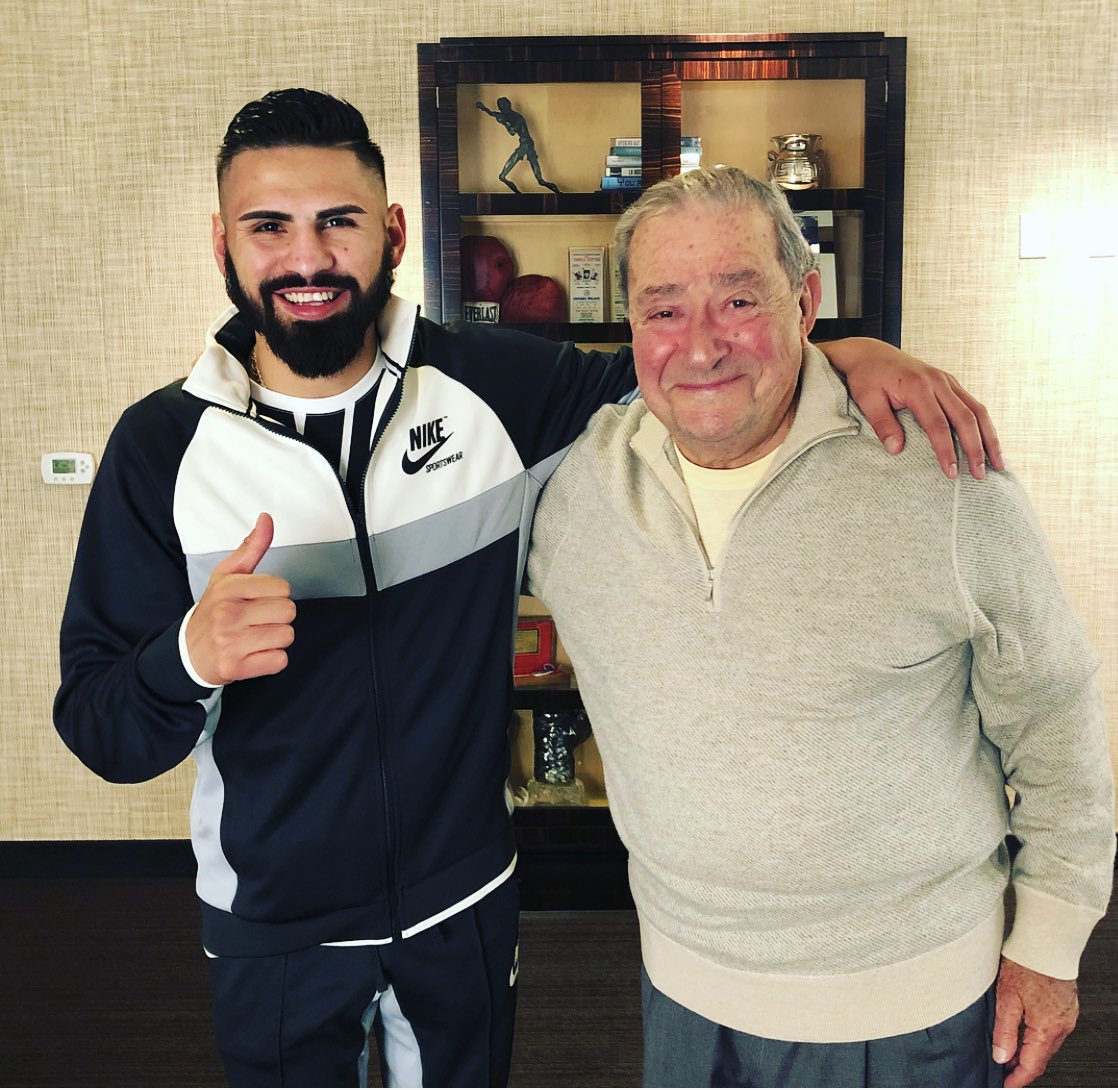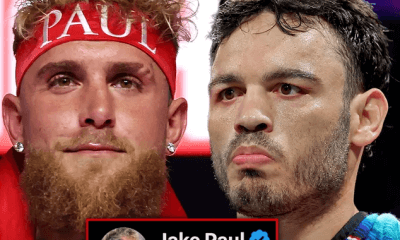Featured Articles
The Avila Perspective, Chap. 32: Crowd Control in the New World Order of Boxing

Hundreds of men dressed in black suits crisscrossed the plaza in packs of twos or threes with green lanyards hanging on their lapels at LA Live.
Our photographer and I navigated through the maze of dark suits in the main plaza toward Wolfgang Puck where Top Rank’s Bob Arum (pictured with WBC super lightweight world champion Jose Carlos Ramirez) sat to meet with various media and talk about the various boxing cards coming up.
Prizefighting has hit another stride with multiple cards clashing with each other in the coming weeks and months. Boxing promoters are butting heads with competing fight cards all over the country. It’s something boxing has not seen in decades.
“Boxing was like this in the 70s and 80s right after the Rocky movies and Sugar Ray Leonard and the Olympics,” said Arum who promoted during that earlier chapter of prizefighting. “You had all categories of boxing on Saturday afternoon on CBS, Sundays NBC and later ABC.”
The major networks are no longer involved with prizefighting but with the arrival of sports networks and sport apps eager to grab an attentive audience through membership deals, a new era has arrived.
Fans have choices now.
Last week rival promoters competed with Premier Boxing Champions staging a welterweight championship fight in Brooklyn, New York butting heads with a Golden Boy Promotions card in Houston, Texas.
One person caught in the middle was trainer Robert Garcia.
New York vs Texas
The Robert Garcia Boxing Academy in the hills of Riverside, Calif has become a hub for many of the best prizefighters in country. On a daily basis you can see champions like Abner Mares or prospects like Lindolfo Delgado and Joshua Franco.
Last Saturday veteran Josesito Lopez fought Keith Thurman for the WBA welterweight title at Barclays Center in Brooklyn while rising contender Vergil Ortiz entered the ring at the Toyota Center in Houston.
Garcia was caught in the middle. To further muddy the conflict, his daughter’s 15th birthday was taking place.
“I had to be there for Josesito’s fight,” said Robert Garcia who asked Josesito’s manager Mikey Garcia (also Robert’s younger brother) to get him a late flight to New York so that he could spend time with his daughter and get to Brooklyn in time for Lopez’s fight with Thurman.
It all worked out.
Lopez traded blows with Thurman and gave fans a competitive fight for 12 rounds. It was an unexpected result for most sports reporters covering the fight who had no idea of Lopez’s background other than his record. They expected the lean Southern Californian to get crushed if Thurman was anywhere near his usual self.
“Josesito did such a great job,” said Robert Garcia. “I had to be at Josesito’s fight. Look at the way he fought. He was more comfortable with me there.”
Garcia was impressed with Thurman as well.
“Thurman boxed pretty well. He looked good,” said Garcia. “He’s a great fighter, one of the best in the welterweight division.”
In Texas, on the same day, things were moving quite comfortably as Vergil Ortiz Jr. had his father and Robert Garcia Jr. working the corner in his fight against Mexico’s Jesus Valdez Barrayan. Ortiz stopped the sturdy Mexican fighter in five rounds though the lightweight from Sonora never was dropped.
“Vergil is special. You saw how he looked,” said Garcia. “He’s a hard worker.”
Ortiz was one of those who sparred with Josesito Lopez and others like Jose Carlos Ramirez and Lindolfo Delgado also added their time in the boxing ring. It’s pretty impressive preparation. And somehow the cross-country dilemma was solved triumphantly.
Carson vs Indio but no Mares
Next weekend the competition revs up again with fights on consecutive nights in Carson and Fresno. Abner Mares was supposed to clash with Gervonta Davis on Saturday but pulled out due to a late injury.
Team Garcia had devised a whole camp toward fighting southpaws with Mares and Ramirez preparing to face lefties in their mutual title fights for Saturday Feb. 9, and Sunday Feb. 10.
“I figured it would be easier to plan if they all were fighting southpaws,” said Robert Garcia who trains both Mares and Ramirez.
But with Mares pulling out, Garcia’s team will be focusing solely on Ramirez when he fights Jose Cepeda who switches between southpaw and orthodox stances.
“We’re ready for anything,” said Garcia.
In Indio, Golden Boy Promotions has a heavy duty fight card on Sept. 9, with every bout featuring TV worthy fighters at Fantasy Springs Casino. DAZN will stream the card.
Two world title fights take the forefront with WBC super bantamweight titlist Rey Vargas defending against Venezuela’s Franklin Manzanilla in a scheduled 12 round clash and Puerto Rico’s Alberto “Explosivo” Machado putting his WBA super featherweight title at stake against Blythe’s Andrew Cancio in another 12 round clash.
Just to add gasoline to the fire, top featherweight contender Jojo Diaz faces Charles Huerta in a 10 round sizzler. Back in the days of the Olympic Auditorium, this fight would have brought the city of Los Angeles to a standstill.
Huerta is a cagey veteran of nearly 20 years who can defeat anyone on a given day. Diaz is a former Olympian who beat then WBA featherweight titlist Jesus Rojas but could not make the required weight so was unable to claim the title despite winning. The match with Huerta is a tantalizingly good match.
Another Olympic Auditorium type fight pits Genaro Gamez against Ivan Delgado. This is going to be extremely interesting. Can the youthful talent of Gamez compete with Delgado’s toughness and experience?
It’s another firefight.
Other top fighters on the card include Azat Hovhannisyan, Oscar Duarte, Ferdinand Kerobyan, Rommel Caballero and Tureano Johnson.
Sunday
Arum, who promotes the Fresno, California fight card on Sunday Feb. 10, said one of the main reasons he likes ESPN is its willingness to put fight cards any day of the week.
“That’s the beauty of ESPN we can fight on a Sunday or a Thursday so we don’t run into conflicts,” said Arum the guru of boxing promotions.
This year promises to raise the roof off of the boxing arena.
Fights to Watch this week
Thurs. Jan. 31, UFC Fight Pass, 7 p.m. Aston Palicte (24-2-1) vs Jose Martinez (20-0-2); Brandon Cruz (6-0) vs. Edward Vazquez (5-0).
Fri. Feb. 1, Showtime, 10 p.m. Ronald Ellis (15-0-2) vs DeAndre Ware (12-1-2); Abraham Nova (14-0) vs Oluwaseun Joshua Wahab (18-0).
Sat. Feb. 2 ESPN, 7 p.m. Oscar Valdez (24-0) vs Carmine Tommasone (19-0); Elieder Alvarez (24-0) vs Sergey Kovalev (32-3-1); Teofimo Lopez (11-0) vs Diego Magdaleno (31-2).
Check out more boxing news on video at The Boxing Channel
To comment on this story in The Fight Forum CLICK HERE
-

 Featured Articles4 weeks ago
Featured Articles4 weeks agoAvila Perspective, Chap. 330: Matchroom in New York plus the Latest on Canelo-Crawford
-

 Featured Articles3 weeks ago
Featured Articles3 weeks agoVito Mielnicki Jr Whitewashes Kamil Gardzielik Before the Home Folks in Newark
-

 Featured Articles12 hours ago
Featured Articles12 hours agoResults and Recaps from New York Where Taylor Edged Serrano Once Again
-

 Featured Articles4 weeks ago
Featured Articles4 weeks agoCatching Up with Clay Moyle Who Talks About His Massive Collection of Boxing Books
-

 Featured Articles5 days ago
Featured Articles5 days agoFrom a Sympathetic Figure to a Pariah: The Travails of Julio Cesar Chavez Jr
-

 Featured Articles3 weeks ago
Featured Articles3 weeks agoMore Medals for Hawaii’s Patricio Family at the USA Boxing Summer Festival
-

 Featured Articles7 days ago
Featured Articles7 days agoCatterall vs Eubank Ends Prematurely; Catterall Wins a Technical Decision
-

 Featured Articles4 weeks ago
Featured Articles4 weeks agoRichardson Hitchins Batters and Stops George Kambosos at Madison Square Garden




















